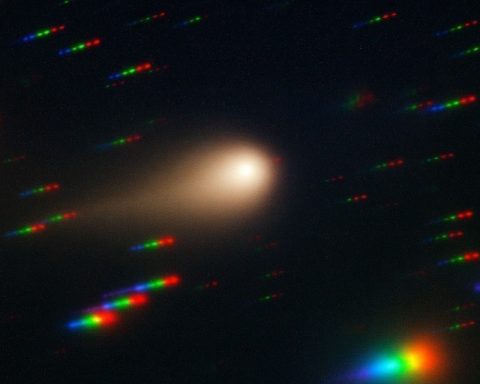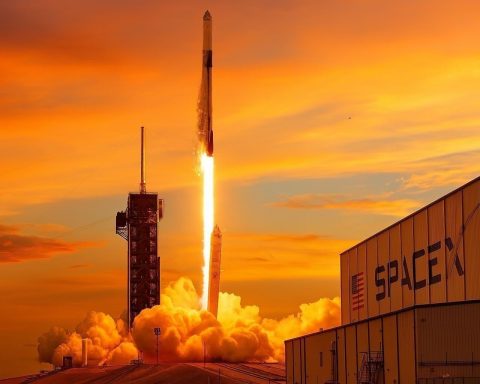- MTG-S1, Europe’s first geostationary meteorological sounder, was launched with an Infrared Sounder and Copernicus Sentinel-4, enabling high-frequency atmospheric data collection over Europe and Africa.
- SpaceX planned the Starlink 10-28 mission for June 8 from Cape Canaveral on a Falcon 9, marking the 59th orbital launch of 2025, and won an $81.6 million USSF-178 contract.
- SpaceX’s Starship exploded over Florida during ascent, scattering debris before four mock satellites could be deployed.
- T-Mobile will launch T-Satellite with Starlink service on July 23, authorized for nearly all phones including the iPhone 13, with full satellite internet rolling out in October.
- MethaneSAT, an $88 million satellite designed to detect methane leaks, lost contact after one year due to solar panel failure.
- The UK Space Agency launched a £75.6 million procurement for a robotic spacecraft to de-orbit two defunct satellites.
- Dstl awarded Astroscale UK a £5.15 million contract for the Orpheus mission, launching in 2027 with two cubesats to study space weather and enhance Space Domain Awareness.
- The $1.5 billion NISAR mission from NASA and ISRO will launch soon, using synthetic aperture radar to monitor Earth’s surface changes in near real-time.
- Interstellar comet 3I/ATLAS is speeding through the solar system at 68 km/s, with a perihelion on October 30, 2025.
- France will invest €1 billion to become the largest shareholder in Eutelsat, boosting European satellite independence.
Space News Roundup: July 2025
The first week of July 2025 has delivered a remarkable array of space news, spanning pioneering satellite launches, environmental discoveries, citizen science breakthroughs, and major industry moves. This comprehensive review explores the latest developments, their implications, and what lies ahead for the global space community.
Europe’s Meteorological Leap: MTG-S1 Geostationary Sounder Launch
Europe has marked a new era in weather forecasting with the successful launch of the MTG-S1, its first geostationary meteorological sounder satellite. MTG-S1 is equipped with an advanced Infrared Sounder and the Copernicus Sentinel-4 instrument, enabling high-frequency atmospheric data collection. This leap in technology promises earlier detection of extreme weather events and more accurate forecasts, directly supporting public safety and health policies.Key Features:- Infrared Sounder: Delivers detailed vertical profiles of temperature and humidity.
- Sentinel-4 Instrument: Monitors air quality, supporting environmental and health policy.
- Geostationary Orbit: Provides continuous coverage over Europe and Africa.
SpaceX: Starlink Expansion and Setbacks
Starlink 10-28 Mission and USSF-178 Contract
SpaceX continues its rapid Starlink deployment with the 59th orbital launch of 2025, scheduled for June 8 from Cape Canaveral. The Falcon 9 will carry another batch of broadband satellites, expanding global internet coverage. Additionally, SpaceX secured an $81.6 million contract for the USSF-178 mission, reinforcing its role as a key defense contractor.[2]Starship Explosion Over Florida
Not all news was positive: a SpaceX Starship rocket exploded over Florida, scattering debris after a loss of contact during ascent. The incident occurred before four mock satellites could be deployed. No casualties were reported, but the event highlights the technical challenges of developing next-generation launch vehicles crucial for NASA’s Artemis lunar program and SpaceX’s Mars ambitions.[3]Starlink in Everyday and Unusual Use
- T-Mobile Partnership: T-Mobile will launch T-Satellite with Starlink service on July 23, now authorized for nearly all phones, including older models like the iPhone 13. Messaging will be available first, with full satellite internet access rolling out in October, improving connectivity in remote and disaster-affected areas.
- Narco-Drone Interception: Colombian authorities intercepted a semi-submersible narco-drone using Starlink satellite internet for remote control and live video transmission, demonstrating both the power and risks of ubiquitous satellite connectivity.
- Employee Welfare: SpaceX is building a lavish private recreation complex, Project Echo, next to its Starlink factory in Bastrop, Texas, reflecting its commitment to staff welfare and its expanding Texas footprint.
Satellite Technology: Innovation, Failure, and Sustainability
Retractable Solar Panels: Tackling Orbital Debris
US startup Atomic-6 is developing retractable solar panels for satellites, aiming to boost maneuverability and reduce collision risks in crowded low Earth orbit. The US Space Force’s $2 million investment in this dual-use technology could significantly improve satellite survival amid the growing threat of space debris.[7]MethaneSAT Failure: A Setback for Climate Monitoring
The $88 million MethaneSAT, designed to detect methane leaks from orbit, lost contact after just one year due to solar panel failure. This jeopardizes critical climate policy efforts and raises concerns about the reliability of space-based environmental surveillance.[8]UK’s Bold Move: Active Space Debris Removal
The UK Space Agency has launched a £75.6 million procurement for a robotic spacecraft to de-orbit two defunct satellites, aiming to reduce orbital debris and protect essential satellite services. This mission, leveraging advanced British robotics, positions the UK as a leader in space sustainability.[9] [10]Astroscale UK’s Orpheus Mission
The UK’s Defence Science and Technology Laboratory (Dstl) awarded Astroscale UK a £5.15 million contract for the Orpheus satellite mission, launching in 2027. Using two cubesats, Orpheus will study space weather and enhance Space Domain Awareness, vital for satellite safety.[11]Environmental Monitoring from Orbit
Lake Mead’s Dramatic Shrinkage
Satellite imagery from NASA’s Landsat 7 and Maxar Technologies reveals a dramatic reduction in Lake Mead’s water levels between 1999 and 2024. The visible “bathtub ring” marks the lake’s historic high water level, and the decline threatens water supply, irrigation, and hydroelectric power for millions.[12] [13]Conservation in Australia
The Australian Conservation Foundation used satellite images to document the illegal clearing of 90,000 hectares of bushland, impacting threatened species habitats. This underscores the critical role of satellite monitoring in environmental protection and policy enforcement.[14]High-Resolution Wealth Mapping in China
Researchers have developed a high-accuracy model for mapping rural household wealth in China by integrating satellite remote sensing and street view imagery. This scalable, cost-effective approach reveals a bimodal spatial distribution of wealth and supports targeted rural policy and resource allocation.[15]JAXA’s GOSAT-GW: Greenhouse Gas Monitoring
Japan’s JAXA launched the GOSAT-GW satellite, featuring the advanced TANSO-3 spectrometer for high-resolution greenhouse gas monitoring. With selectable swath modes, it enables both global and localized emission analysis, strengthening efforts to monitor CO₂ and methane worldwide.[16]NISAR: Real-Time Earth Observation
The $1.5 billion NISAR satellite, a joint NASA-ISRO mission, is set to launch soon from India. Using synthetic aperture radar (SAR), NISAR will monitor Earth’s surface changes in near real-time, day or night, through clouds or smoke—providing unprecedented data for climate science, agriculture, and disaster response.[17]Space-Based Disaster Response and Connectivity
Zhuzhou’s Satellite Emergency Terminals
Zhuzhou City deployed ‘Xinglitong’ satellite emergency terminals in remote villages, ensuring reliable communication during severe floods. These portable devices provide instant satellite connectivity when conventional networks fail, significantly enhancing disaster response capabilities and offering a replicable model for rural China.[18]Fengyun Meteorological Satellites for Pacific Islands
China’s Fengyun meteorological satellites provide high-frequency disaster monitoring to Pacific island nations, aiding in typhoon, volcano, and earthquake response. The satellites deliver real-time data and remote sensing services, supporting early warning and climate resilience.[19]Citizen Science and Astronomical Discoveries
Kilonova Project: Exploding Star Discovery
Citizen scientists with the Kilonova Project made a breakthrough by identifying an exploding star using data from the Gravitational-wave Optical Transient Observer (GOTO). Volunteers classified nearly 240,000 objects, enabling rapid follow-up and the discovery of cataclysmic variable star GOTO0650 within hours.[20]Double-Detonation Supernovae: New Evidence
Astronomers have found evidence that some type Ia supernovae may result from a double detonation: an initial helium fusion on a white dwarf’s surface triggers a second, larger explosion in its carbon-oxygen core. This mechanism could explain supernovae occurring before white dwarfs reach critical mass.[21]First Visual Evidence of Double-Detonation Supernova
Using the Very Large Telescope, astronomers captured the first visual evidence of a star exploding twice, confirming the double detonation phenomenon in supernova SNR 0509-67.5. This rare event offers new insights into stellar deaths and cosmic expansion.[22]Interstellar Visitors: Comet 3I/ATLAS
A newly confirmed interstellar comet, 3I/ATLAS, is racing through our solar system at 68 km/s. Only the third such object ever detected, it offers a rare opportunity for astronomers to study materials from beyond our solar system. The comet will reach perihelion on October 30, 2025.[23] [24] [25]Space Industry and Policy: Global Developments
Amazon’s Project Kuiper: Satellite Telecom in Europe
Amazon has launched satellite telecom services in Europe via Project Kuiper, starting in France, Germany, and the UK. The Kuiper network aims to deploy thousands of satellites for global coverage, competing with Starlink and benefiting individuals, businesses, and governments in underserved areas.[26]France Invests in Eutelsat
France will invest €1 billion to become the largest shareholder in Eutelsat, aiming to boost European satellite independence and counter reliance on Starlink and other non-European providers. This move supports Eutelsat’s expansion and European strategic autonomy.[27]China’s BeiDou: GPS Rival and Geopolitical Tool
China’s BeiDou satellite constellation rivals the US GPS, offering unique features like centimeter-level accuracy, satellite messaging, and rapid localization. Its adoption, especially in the Global South, boosts China’s technological autonomy and geopolitical influence, raising data security concerns in the West.[28]Sateliot and Alén Space: Building a 5G LEO Constellation
Sateliot has selected Alén Space to manufacture five new LEO satellites for its 5G dual-use constellation, aiming for launch in 2026. Built in Spain, these satellites will enhance Sateliot’s global, interoperable coverage.[29]Xiong’an: China’s Satellite Innovation Hub
Xiong’an New Area hosted the ‘Satellite Payload Enterprises Xiong’an Tour’ to promote the space information industry and strengthen the satellite internet industry chain, reinforcing its role as a hub for commercial space and satellite innovation in China.[30]Space Heritage and Education
Space Shuttle Relocation
President Trump’s spending bill allocates $85 million to move a Space Shuttle, highlighting ongoing investment in space heritage preservation and infrastructure.[31]Croydon High School CubeSat Launch
Students at Croydon High School for Girls designed and built a CubeSat, which was successfully launched into low Earth orbit. The miniature satellite records sunlight, bringing students’ space ambitions closer to reality.[32]Space Science on the ISS
ESA Astronaut Sophie Adenot: Haute Cuisine in Space
ESA astronaut Sophie Adenot collaborated with Michelin-starred chef Anne-Sophie Pic to create gourmet French dishes for her ISS mission, aiming to bring a taste of home and emotional connection to space.[33]Ax-4 and Expedition 73: Research Highlights
- Ax-4 Mission: The crew continued scientific research on muscle biology, radiation, neural activity, and more, including the Space Micro Algae experiment and Bone on ISS study.
- Expedition 73: Astronauts focused on muscle, heart, and brain research, and prepared for a Progress 92 cargo mission, supporting advancements in space health and adaptation.
- Bengaluru Tardigrades: Indian astronaut Shubhanshu Shukla completed a microgravity experiment on tardigrades from Bengaluru, offering insights for therapeutics and future space missions.
Commercial and Military Satellite Developments
Boeing’s Next-Gen Strategic Communication Satellites
Boeing secured a $2.8 billion contract to build two next-generation ESS satellites for the US Department of Defense, providing secure, resilient communications for military and presidential use, including nuclear command. These satellites are designed to withstand extreme threats, signaling a new era in strategic space communications.[37] [38]SES O3b mPOWER Satellites
Boeing delivered the 9th and 10th O3b mPOWER satellites to SES, featuring software-defined payload technology for adaptable, high-speed global connectivity. These satellites will boost capacity and reliability for SES’s MEO constellation.[39]Lunar and Planetary Science
Portsoy Rocks: Lunar Instrument Development
Researchers from the University of Aberdeen are using Portsoy’s unique geology to develop a hand-held instrument for astronauts to analyze rocks on the Moon, advancing lunar exploration technology.[40]Siljan Ring: Sweden’s Ancient Impact Crater
Satellite images from NASA’s Landsat 8 reveal the Siljan Ring, Europe’s largest-known impact crater, in Sweden. Recent research found the crater’s rocks suitable for ancient life, with fossilized fungi discovered over 500 meters deep.[41]Notable Auctions and Space Heritage
Martian Meteorite NWA 16788 Up for Auction
The largest Martian meteorite ever found on Earth, NWA 16788 (24.67 kg), is set for auction at Sotheby’s, with an estimated price of $4 million. The sale has sparked debate among experts about the balance between private collecting and public science.[42] [43] [44]Space Weather and “Zombie” Satellites
NASA’s Relay 2 “Zombie” Satellite
A NASA Relay 2 satellite, inactive since 1967, emitted a powerful radio burst in June 2024, likely caused by a micrometeorite impact or static buildup. This unexpected signal from Earth’s orbit has intrigued scientists and highlights the unpredictable nature of aging space hardware.[45]China’s Satellite Achievements
Shiyan-28B 01: Space Environment Exploration
China launched the Shiyan-28B 01 satellite for space environment exploration and technology testing, marking the 583rd mission of the Long March rocket series.[46]Zhongxing-9C: Communications Satellite
China successfully launched the Zhongxing-9C satellite using the Long March 3B rocket, further expanding its communications infrastructure.[47]DRO-A/B Satellites: Recovery Success
China’s DRO-A/B satellites, initially off-course after a launch anomaly, were successfully stabilized and maneuvered into Distant Retrograde Orbit (DRO) after 123 days, thanks to a young research team’s efforts. This marks a major milestone in deep space exploration and satellite recovery.[48]Commercial Rocketry: Honda’s Reusable Rocket
Honda achieved a major milestone by successfully launching and landing its 20.6ft reusable rocket for the first time in Japan. The test demonstrated key reusability technologies, with the rocket landing within 14.5 inches of its target. Honda aims for a suborbital launch by 2029, targeting the growing demand for satellite launches.[49] [50]Atmospheric Phenomena: Red Sprites from the ISS
NASA astronaut Nichole Ayers, aboard the ISS, photographed a rare red sprite—an upper-atmosphere electrical phenomenon—above thunderstorms. Such images help scientists study the formation and characteristics of transient luminous events (TLEs) and their link to thunderstorms.[51] [52]Upcoming Astronomy Events: July 2025
- Full Buck Moon: Peaks July 10, visible across the US and globally.
- Meteor Showers: Alpha Capricornids and Southern Delta Aquariids peak July 29-30, best viewed from dark sky parks.
- Milky Way Viewing: Excellent in dark-sky locations in Indiana and elsewhere.
- Pluto at Perigee: Rare viewing opportunity on July 25.
Outlook: The Road Ahead
Trends to Watch
- Satellite Sustainability: With debris removal missions and retractable solar panels, the industry is prioritizing orbital safety.
- Environmental Monitoring: Satellites are increasingly vital for climate science, disaster response, and resource management.
- Commercial Competition: Amazon’s Kuiper, SpaceX’s Starlink, and China’s BeiDou are driving global connectivity and geopolitical shifts.
- Citizen Science: Public involvement in astronomical discoveries is accelerating, democratizing space research.
- Reusable Rockets: Honda’s entry signals broader competition and innovation in launch services.
Challenges
- Space Debris: Growing satellite constellations increase collision risks, demanding urgent solutions.
- Satellite Reliability: Failures like MethaneSAT highlight the need for robust engineering and redundancy.
- Geopolitical Tensions: Satellite navigation and communications are becoming arenas for strategic competition.
Opportunities
- Global Connectivity: Satellite internet is bridging digital divides, especially in remote and underserved regions.
- Climate Action: Enhanced monitoring supports evidence-based policy and rapid response to environmental crises.
- STEM Education: Student CubeSat projects and citizen science initiatives are inspiring the next generation.
Recap: This Week in Space
- Europe launched its first geostationary sounder, MTG-S1, for advanced weather monitoring.
- SpaceX continued Starlink expansion but suffered a Starship explosion.
- The UK and Japan advanced satellite sustainability and environmental monitoring.
- Citizen scientists discovered an exploding star, and astronomers confirmed double-detonation supernovae.
- Interstellar comet 3I/ATLAS offers a rare research opportunity.
- Amazon and France made strategic moves in satellite telecom.
- Honda’s reusable rocket marks new competition in launch services.
- Atmospheric phenomena and upcoming sky events promise excitement for observers.
The universe never stands still, and neither does the global space community. As new technologies launch, old satellites surprise, and citizen scientists make headlines, the future of space exploration and utilization looks more dynamic—and more essential—than ever.
More today’s sources
Europe Launches First Geostationary Sounder Satellite MTG-S1
Europe has launched MTG-S1, its first geostationary meteorological sounder satellite. MTG-S1 provides high-frequency atmospheric data, enabling earlier extreme weather detection and improved forecasts. It features an Infrared Sounder and the Copernicus Sentinel-4 instrument, supporting air quality monitoring and public health policies.
Continue reading on [57]
SpaceX Targets June 8 Starlink Satellite Launch from Cape Canaveral
SpaceX plans a Falcon 9 launch for the Starlink 10-28 mission early Tuesday, June 8, from Cape Canaveral, deploying more broadband satellites to low-Earth orbit. The 4.5-hour window opens at 1:48 a.m. This marks the 59th orbital launch of 2025 from the site. SpaceX also secured an $81.6M contract for a future USSF-178 mission.
Continue reading on [58]
ESA Astronaut Sophie Adenot Brings French Haute Cuisine to the ISS
ESA astronaut Sophie Adenot collaborates with Michelin-starred chef Anne-Sophie Pic to create gourmet French dishes for her ISS mission εpsilon. The custom menu, designed to meet space food requirements, aims to bring a taste of home and emotional connection to space. Pic calls it an “exhilarating challenge” and a “true honor.”
Continue reading on [59]
Zhuzhou Deploys Satellite Emergency Terminals to Remote Villages for Flood Response
Zhuzhou City has deployed ‘Xinglitong’ satellite emergency terminals in remote villages of Yanling County, ensuring a reliable communication lifeline during severe floods. The portable devices provide instant satellite connectivity when conventional networks fail, significantly enhancing local disaster response capabilities and offering a replicable model for emergency communications in rural China.
Continue reading on [60]
Satellite Images Reveal Dramatic Shrinkage of Lake Mead Over 25 Years
Satellite imagery from NASA’s Landsat 7 and Maxar Technologies shows a dramatic reduction in Lake Mead’s water levels between 1999 and 2024. Experts warn this decline threatens water supply, irrigation, and hydroelectric power for millions. Colin Williams (USGS) explains the visible “bathtub ring” marks the lake’s historic high water level.
Continue reading on [61]
UK Seeks Supplier for Space Robot to Remove Defunct Satellites
The UK Space Agency has launched a £75.6 million tender for a robotic spacecraft to de-orbit two defunct satellites from low Earth orbit. The mission aims to reduce orbital debris and protect essential satellite services. Dr Paul Bate stated, “It’s about securing the future of space for everyone, delivering tangible benefits here on Earth.”
Continue reading on [62]
Citizen Scientists Discover Exploding Star with Kilonova Project and GOTO
Citizen scientists with the Kilonova Project achieved a breakthrough by identifying an exploding star using data from the Gravitational-wave Optical Transient Observer (GOTO). Volunteers classified nearly 240,000 objects, enabling rapid follow-up. Dr. Tom Killestein stated, “Kilonova Seekers is a unique opportunity for members of the public to take part in true real-time astrophysics.”
Continue reading on [63]
Citizen Scientists Discover Exploding Star with Kilonova Project and GOTO
Citizen scientists with the Kilonova Project achieved a breakthrough by identifying an exploding star using data from the Gravitational-wave Optical Transient Observer (GOTO). Their rapid response enabled timely follow-up, leading to the discovery of cataclysmic variable star GOTO0650. Dr. Tom Killestein noted, “public volunteers identified this star…within 3 1/2 hours.”
Continue reading on [64]
High-Resolution Mapping of Rural Wealth in China Using Satellite and Street View Imagery
Researchers developed a high-accuracy model (R²=71%) for mapping rural household wealth in China by integrating satellite remote sensing and street view imagery. This scalable approach reveals a bimodal spatial distribution of wealth and offers a cost-effective alternative to traditional surveys, aiding targeted rural policy and resource allocation.
Continue reading on [65]
Satellite Images Reveal Lake Mead’s Dramatic Shrinkage Over 25 Years
Satellite images from USGS and NASA’s Landsat 7 show a dramatic reduction in Lake Mead’s water levels over 25 years, threatening water supply and hydropower for millions. Maxar Technologies imagery highlights the visible ‘bathtub ring.’ As Collin Williams (USGS) notes: “The lake’s bathtub ring appears as water levels drop below 1,229 feet.”
Continue reading on [66]
High-Resolution Mapping of Rural Wealth in China Using Satellite and Street View Imagery
Researchers developed a high-accuracy township-level wealth prediction model (R² = 71%) for rural China by integrating satellite remote sensing and street view imagery. This approach enables scalable, fine-grained mapping of rural wealth, revealing a bimodal spatial distribution and supporting more targeted rural policy implementation.
Continue reading on [67]
Satellite Images Reveal Lake Mead’s Dramatic Shrinkage Over 25 Years
Satellite images from NASA’s Landsat 7 and Maxar Technologies show a dramatic reduction in Lake Mead’s water levels over 25 years, exposing the ‘bathtub ring.’ USGS expert Collin Williams explained, “The lake’s bathtub ring is the result of calcium carbonate left as water levels drop.” The reservoir is now at historic lows, threatening water and power supplies.
Continue reading on [68]
NASA ‘Zombie’ Satellite Emits Radio Signal After 60 Years of Silence
A NASA Relay 2 satellite, inactive since 1967, emitted a powerful radio burst in June 2024, surprising scientists. The signal, lasting just 30 nanoseconds, likely resulted from a micrometeorite impact or static buildup. “This was an incredibly powerful radio signal,” said lead author Clancy James, highlighting its unexpected origin from Earth’s orbit.
Continue reading on [69]
Retractable Solar Panels for Satellites: Atomic-6 Tackles Orbital Debris
US startup Atomic-6 is developing retractable solar panels for satellites to boost maneuverability and reduce collision risks in congested low Earth orbit. The US Space Force is investing $2 million to accelerate this dual-use technology, which could significantly improve satellite survival amid rising space debris threats.
Continue reading on [70]
Defense Department Halts Sharing of Crucial Satellite Weather Data with Forecasters
The U.S. Department of Defense will stop providing satellite weather data to hurricane forecasters, ending a 40-year practice. Experts warn this loss will impact real-time hurricane forecasting and sea ice monitoring. “This is data that forecasters use regularly,” said Brian Tang, hurricane researcher at University at Albany. The decision is due to cybersecurity concerns.
Continue reading on [71]
World’s Largest Martian Meteorite NWA 16788 to Be Auctioned for $4 Million
The largest Martian meteorite ever found on Earth, NWA 16788, weighing 24.67 kg, is set for auction in New York. Estimated at $4 million (₹34 crore), it’s about 70% larger than the previous record-holder, Taoudenni 002. This rare space rock offers unique insights into Mars’ geology.
Continue reading on [72]
Xiong’an New Area Hosts ‘Satellite Payload Enterprises Xiong’an Tour’ to Boost Space Industry
Xiong’an New Area hosted the ‘Satellite Payload Enterprises Xiong’an Tour’ to promote the space information industry and strengthen the satellite internet industry chain. The event featured enterprise showcases, policy briefings, and industry collaboration, reinforcing Xiong’an’s role as a hub for commercial space and satellite innovation in China.
Continue reading on [73]
Dstl Awards Orpheus Satellite Mission Contract to Astroscale UK
The UK’s Defence Science and Technology Laboratory (Dstl) has awarded a £5.15 million contract to Astroscale UK for the Orpheus satellite mission. Launching in 2027, Orpheus will use two cubesats to study space weather and enhance Space Domain Awareness. Dstl’s Dr Paul Hollinshead stated, “Changes in space weather can have a critical impact on satellites.”
Continue reading on [74]
Conservation Group Uses Satellite Imagery to Uncover Mass Habitat Loss in Australia
The Australian Conservation Foundation (ACF) used satellite images to document the illegal clearing of 90,000 hectares of bushland, impacting threatened species habitats. ACF’s Nathaniel Pelle stated, “Among these 90,000 hectares…the majority of it is identifiable as cattle properties.” The findings highlight the critical role of satellite monitoring in environmental protection.
Continue reading on [75]
Croydon High School Students Launch CubeSat into Low Earth Orbit
Students at Croydon High School for Girls designed and built a CubeSat, a miniature satellite that records sunlight in Earth’s orbit. After a year of work, the satellite was successfully launched into low Earth orbit, bringing the students’ space ambitions closer to reality.
Continue reading on [76]
China Launches Shiyan-28B 01 Satellite for Space Environment Exploration
China launched the Shiyan-28B 01 satellite from Xichang using a Long March-4C rocket. The satellite will be used for space environment exploration and technology testing. This marks the 583rd mission of the Long March rocket series.
Continue reading on [77]
MethaneSAT Failure: $88 Million Methane-Hunting Satellite Loses Contact
The advanced MethaneSAT satellite, designed to detect methane leaks from orbit, has lost contact after just one year in service. Operators confirm solar panels failed and data may be lost, jeopardizing climate policy efforts. The mission’s abrupt end raises concerns about monitoring industrial emissions and the reliability of space-based environmental surveillance.
Continue reading on [78]
UK Space Agency Launches £75.6M Tender for Active Space Debris Removal Mission
The UK Space Agency has initiated a £75.6 million procurement for its first mission to remove defunct satellites from orbit, using advanced British robotics. This bold step aims to tackle space debris, safeguard vital satellite services like GPS and weather forecasting, and strengthen the UK’s leadership in space sustainability and innovation.
Continue reading on [79]
Portsoy Rocks Aid Development of Lunar Exploration Instruments
Researchers from the University of Aberdeen are using Portsoy’s unique geology to develop a hand-held instrument for astronauts to analyze rocks on the Moon. Professor John Parnell said, “Portsoy is in a select position to help us develop equipment to test for that and gain the understanding we need here on Earth.”
Continue reading on [80]
Siljan Ring: Sweden’s Ancient Impact Crater Revealed by Satellite
Satellite images from NASA’s Landsat 8 reveal the Siljan Ring, Europe’s largest-known impact crater, in Sweden. Formed 380 million years ago, the structure remains visible from space. Recent research using drill cores found the crater’s rocks suitable for ancient life, with fossilized fungi discovered over 500 meters deep.
Continue reading on [81]
Boeing to Develop Next-Gen Strategic Communication Satellites for US Military
Boeing secured a $2.8 billion contract to build two next-generation ESS satellites for the US Department of Defense, delivering the first by 2031. ESS satellites will provide secure, resilient communications for US military and presidential use, including nuclear command, operating in geostationary orbit and designed to withstand extreme threats.
Continue reading on [82]
Ax-4 Mission Day 8: Scientific Research and Technology Demonstrations on ISS
The Ax-4 crew aboard the ISS continued scientific research, including muscle biology, radiation, and neural activity studies. Highlights include the Space Micro Algae experiment, wearable tech for noise monitoring, and the Bone on ISS study. The mission fosters global outreach and advances knowledge for both spaceflight and Earth applications.
Continue reading on [83]
Expedition 73 Crew Conducts Muscle, Brain, and Heart Research Ahead of Cargo Mission Swap
Expedition 73 astronauts aboard the International Space Station focused on muscle, heart, and brain research, including electrical muscle stimulation and cognitive tests. The crew also prepared for a Progress 92 cargo mission, while Axiom Mission 4 astronauts contributed to complementary biology studies, supporting advancements in space health and adaptation.
Continue reading on [84]
Bengaluru Tardigrades Complete Space Experiment on Axiom-4 Mission
Indian astronaut Shubhanshu Shukla completed a microgravity experiment on tardigrades (‘water bears’) from Bengaluru aboard the ISS during the Axiom-4 mission. The study, led by IISc, focused on their survival and resilience in space, offering insights for therapeutics and future space missions. ISRO confirmed the experiment’s success.
Continue reading on [85]
China Successfully Launches Zhongxing-9C Satellite with Long March 3B
On June 20, China launched the Zhongxing-9C satellite using the Long March 3B rocket from Xichang Satellite Launch Center. The satellite entered its designated orbit, marking the 582nd flight of the Long March series. Zhongxing-9C, Long March 3B, and satellite launch are key highlights.
Continue reading on [86]
Astronomers Discover High-Velocity Alien Gas Clouds Entering Nearby Galaxy M83
Astronomers have detected high-velocity gas clouds (HVCs) near the M83 galaxy, moving at unusual speeds and possibly originating from outside the galaxy. This finding, led by Maki Nagata, offers critical insights into how galaxies sustain star formation over billions of years by accreting external gas. “What makes HVCs special is their speed and direction,” Nagata explained.
Continue reading on [87]
China’s BeiDou: The Alternative to US Satellite Navigation
China’s BeiDou satellite constellation rivals the US GPS, offering unique features like centimeter-level accuracy, satellite messaging, and rapid localization. It underpins China’s satellite self-sufficiency and expands global influence, especially in Asia, Africa, and the Middle East. BeiDou’s adoption raises geopolitical and data security concerns in the West.
Continue reading on [88]
China’s BeiDou: The Alternative to US Satellite Navigation
China’s BeiDou satellite constellation rivals GPS with unique features like rapid location, satellite messaging, and centimeter-level accuracy. Its global adoption, especially in the Global South, boosts China’s technological autonomy and geopolitical influence. As one expert notes, BeiDou is now a ‘tool of soft power,’ raising Western concerns over data security and dependency.
Continue reading on [89]
Largest Martian Meteorite on Earth Up for Auction at Sotheby’s
The largest known Martian meteorite on Earth, NWA 16788, weighing 54 lbs, will be auctioned at Sotheby’s on July 16 and could fetch up to $4 million. Experts debate its sale: “It belongs in a museum,” said Prof. Steve Brusatte, while others note private collecting drives science.
Continue reading on [90]
Amazon Launches Satellite Telecom Services in Europe with Project Kuiper
Amazon introduces satellite telecom services in Europe, starting in France, Germany, and the UK. The Kuiper network aims to deploy thousands of satellites for global coverage, competing with Starlink’s 6,000 satellites. The service will benefit individuals, businesses, and governments, especially in remote areas lacking reliable internet access.
Continue reading on [91]
Largest Martian Meteorite on Earth Heads to Sotheby’s Auction for $4 Million
The largest known Martian meteorite on Earth, NWA-16788 (24.67 kg), is set for auction at Sotheby’s, with an estimated price of US$4 million. Experts debate its sale: ‘It belongs in a museum,’ says Steve Brusatte, while Julia Cartwright notes, ‘The scientific interest will remain.’ Auction starts July 16.
Continue reading on [92]
France Becomes Largest Shareholder in Eutelsat, Boosting European Satellite Independence
France will invest €1 billion to become the largest shareholder in Eutelsat, operator for Polsat Box and Canal+. President Macron emphasized Europe’s need for independent satellite infrastructure: “Europe cannot accept dependence on non-European telecom infrastructure.” The move counters reliance on Starlink and supports Eutelsat’s expansion against US and Chinese competitors.
Continue reading on [93]
New Evidence Supports Double Detonation Theory for Type Ia Supernovae
Astronomers have found evidence that some type Ia supernovae may result from a double detonation: an initial helium fusion on a white dwarf’s surface triggers a second, larger explosion in its carbon-oxygen core. This mechanism could explain supernovae occurring before white dwarfs reach critical mass, offering new insights into stellar explosions.
Continue reading on [94]
Voyager 1 to Become First Human-Made Object One Light-Day from Earth in 2026
NASA’s Voyager 1 will make history in November 2026 as the first spacecraft to reach a distance from Earth equal to one light-day—about 16 billion miles. Launched in 1977, Voyager 1 continues to push the boundaries of human exploration, highlighting the vastness of space and the limits of current technology.
Continue reading on [95]
Astronomers Capture First Visual Evidence of Double-Detonation Supernova
Astronomers using the Very Large Telescope have captured the first visual evidence of a star exploding twice, confirming the long-suspected double detonation phenomenon. This rare event, observed in supernova SNR 0509-67.5, reveals how a white dwarf triggers two explosive bursts, offering new insights into stellar deaths and cosmic expansion.
Continue reading on [96]
US Air Force Halts SpaceX Hypersonic Rocket Cargo Project Over Environmental Concerns
The US Air Force has abandoned its plan to test hypersonic rocket cargo deliveries with SpaceX at Johnston Atoll due to concerns about seabird habitats. The project sought rapid cargo delivery but faced backlash over potential harm to local wildlife, prompting the search for alternative locations.
Continue reading on [97]
Boeing Delivers 9th and 10th O3b mPOWER Satellites to SES for Enhanced Global Connectivity
Boeing has delivered the 9th and 10th O3b mPOWER satellites to SES, featuring software-defined payload technology for adaptable, high-speed global connectivity. These satellites, part of SES’s MEO constellation, will boost capacity and reliability. Michelle Parker of Boeing stated, “It’s a game changer, and the first eight satellites are showing users just how incredible this technology is.”
Continue reading on [98]
Interstellar Comet 3I/ATLAS Speeds Through Solar System, Offers Rare Study Opportunity
A newly confirmed interstellar comet, 3I/ATLAS, is racing through our solar system at 68 km/s. This third-ever detected interstellar visitor provides a rare opportunity for astronomers to study materials from beyond our solar system. The comet will reach perihelion on Oct. 30, offering valuable insights into interstellar objects.
Continue reading on [99]
SpaceX Starship Rocket Explodes Over Florida, Debris Falls After Loss of Contact
A SpaceX Starship rocket exploded after launch, scattering debris over Florida. SpaceX stated: “During Starship’s ascent burn, the vehicle experienced a rapid unscheduled disassembly and contact was lost.” The incident occurred before four mock satellites could be deployed. No casualties were reported. Starship is crucial for NASA’s future lunar missions and SpaceX’s Mars ambitions.
Continue reading on [100]
Alén Space to Build Five New LEO Satellites for Sateliot’s 5G Constellation
Sateliot has selected Alén Space to manufacture five new LEO satellites for its 5G dual-use constellation, aiming for launch in 2026. The satellites, built in Spain, will enhance Sateliot’s global, interoperable coverage. “Este proyecto demuestra que en España somos capaces de construir infraestructura crítica desde cero,” said Sateliot CEO Jaume Sanpera.
Continue reading on [101]
NASA Confirms Third Interstellar Object, 3I/ATLAS, Passing Through Solar System
NASA has confirmed a mysterious object, now named 3I/ATLAS (C/2025 N1), as only the third known interstellar visitor to our solar system. The object, likely a comet, is traveling at 152,000 mph and will not remain in the solar system for long. “Tentative signs of cometary activity” have been observed, NASA stated.
Continue reading on [102]
Colombian Authorities Intercept Maritime Narco-Drone Controlled via Starlink Satellite Internet
Colombian Navy intercepted a semi-submersible narco-drone using Starlink satellite internet for remote control and live video transmission. The unmanned vehicle could carry up to 1.5 tons of cargo, showcasing how satellite internet enables advanced remote operations—even for illicit activities.
Continue reading on [103]
T-Mobile Expands Starlink Satellite Internet to Older Phones Like iPhone 13
T-Mobile will launch its T-Satellite with Starlink service on July 23, now authorized by the FCC to support nearly all phones, including older models like the iPhone 13. The service, initially offering messaging, will expand to satellite internet access from October 1, enhancing connectivity in remote and disaster-affected areas.
Continue reading on [104]
Pentagon Invests Billions in Boeing’s ‘Doomsday’ Satellites for Nuclear-Resilient Communications
Boeing secured a $2.8B Pentagon contract for two ESS satellites designed to survive nuclear war, with launches set for 2031. Geostationary orbits are no longer secure; these satellites use advanced encryption and may serve as a ‘black box’ for command continuity. Analysts see this as a sign of a new ‘Cold War 2.0’ in satellite communications.
Continue reading on [105]
Satellite Connectivity in Mobile Phones: Current Models and Uses
Satellite connectivity in smartphones enables emergency messaging and location sharing when outside cellular coverage. Currently, only select models like iPhone 14/15 and Huawei Mate 50/60 series offer this feature, mainly for emergencies. Availability is limited by region and device, but expansion is expected. “Ahora todo ello es posible gracias a que están empezando las conexiones satelitales en nuestro país.”
Continue reading on [106]
July 2025 Astronomy Events: Full Buck Moon and Meteor Showers Over Michigan
Michigan skies will feature the Buck Moon peaking July 10, 2025, and two meteor showers—the alpha Capricornids and Southern Delta Aquariids—peaking July 29-30. According to NASA, the Southern Delta Aquariids typically produce 7-8 meteors per hour. Best viewing is from Michigan’s dark sky parks under clear conditions.
Continue reading on [107]
SpaceX Plans Private Recreation Complex for Texas Starlink Factory Staff
SpaceX will build a lavish private recreation complex, dubbed Project Echo, next to its Starlink factory in Bastrop, Texas. The facility, for employees only, will feature courts, picnic areas, and a floating deck. The expansion highlights SpaceX’s commitment to staff welfare and its growing presence in Texas.
Continue reading on [108]
JAXA Launches GOSAT-GW Satellite to Enhance Greenhouse Gas Monitoring
Japan’s JAXA launched the GOSAT-GW satellite, featuring the advanced TANSO-3 spectrometer for high-resolution greenhouse gas monitoring. With selectable swath modes, it enables both global and localized emission analysis. Data will be validated using surface and airborne networks, strengthening efforts to monitor CO₂ and methane concentrations worldwide.
Continue reading on [109]
July 2025 Full Buck Moon and Milky Way Viewing in Indiana: Dates, Times, and Best Spots
July’s full moon—the Buck Moon—will rise over Indiana on July 10, 2025, with moonrise in Indianapolis at 9:39 p.m., according to NASA. The Milky Way is also visible in dark-sky locations like Beverly Shores. For best viewing, avoid city lights and check weather forecasts for clear skies.
Continue reading on [110]
How and When to See July 2025’s Full Moon, Delta Aquariid Meteor Shower, and More
July 2025 offers skywatchers a full Moon on July 10, the Delta Aquariid meteor shower peaking July 28–29, and a rare chance to spot Pluto at perigee on July 25. A close conjunction of the Moon and Mars occurs before dawn on July 29. Dark skies and clear weather will enhance viewing.
Continue reading on [111]
July 2025 Buck Moon: Full Moon Date, Viewing Tips, and Cultural Origins for California
The Buck Moon will reach full phase on July 10, 2025, visible in California from around 8:30 p.m. The moon will appear nearly full from July 8–12. The name reflects seasonal changes observed by Native American tribes. “Each tribe has a close relationship with the land, and their moon names reflect unique seasonal changes,” said Britt Lundren, UNC Asheville.
Continue reading on [112]
US Air Force Halts SpaceX Hypersonic Rocket Cargo Project Over Environmental Concerns
The US Air Force has suspended its plan with SpaceX to test hypersonic rocket cargo deliveries from Johnston Atoll, following concerns from biologists about harm to nesting seabirds. The Air Force is now seeking alternative locations for the project.
Continue reading on [113]
NISAR Satellite to Launch: $1.5 Billion NASA-ISRO Mission for Real-Time Earth Observation
The 3-tonne, $1.5 billion NISAR satellite, a joint NASA-ISRO mission, will launch soon from India. Using synthetic aperture radar (SAR), NISAR can monitor Earth’s surface changes in near real-time, day or night, through clouds or smoke—providing unprecedented data for climate science, agriculture, and disaster response. “SAR satellites can take images… both during the day and night.”
Continue reading on [114]
Honda Successfully Launches and Lands 20.6ft Reusable Rocket for the First Time
Honda achieved a major milestone by successfully launching and landing its 20.6ft reusable rocket for the first time in Taiki Town, Japan. The test demonstrated key reusability technologies, with the rocket reaching 890ft and landing within 14.5 inches of its target. Honda aims for a suborbital launch by 2029.
Continue reading on [115]
Honda Enters Space Industry with Reusable Rocket Launch
Honda has successfully launched a reusable rocket, marking its entry into the space industry. The test demonstrated precise vertical landing, aiming to cut costs and emissions. CEO Toshihiro Mibe highlighted the rocket as proof of Honda’s technological prowess. Honda plans a suborbital launch by 2029, targeting the growing demand for satellite launches.
Continue reading on [116]
China’s DRO-A/B Satellites Successfully Rescued After 123 Days Off Course
China’s DRO-A/B satellites suffered a launch anomaly in March 2024, missing their intended orbit. After 123 days, a young research team, including students who wrote 20,000 lines of code, successfully stabilized and maneuvered the satellites into the Distant Retrograde Orbit (DRO). The mission marks a major milestone in deep space exploration and satellite recovery.
Continue reading on [117]
Astronomers Track Rare Interstellar Comet 3I/ATLAS
Astronomers are closely monitoring interstellar comet 3I/ATLAS, only the third such object ever observed. Currently 670 million km from the Sun, it will approach closest in October 2025. Experts highlight its “absolutely foreign nature” and the unique insights it offers into other planetary systems. “Spotting a possible interstellar object is incredibly rare,” said Professor John Tonry.
Continue reading on [118]
NASA Astronaut Captures Rare Red Sprite Phenomenon from ISS
NASA astronaut Nichole Ayers, aboard the ISS as SpaceX Crew-10 pilot, photographed a rare red sprite—a transient luminous event—above thunderstorms on July 3, 2025. “Just. Wow … I caught this sprite,” Ayers shared. Such images help scientists study the formation and characteristics of TLEs (transient luminous events) and their link to thunderstorms.
Continue reading on [119]
NASA Astronaut Captures Rare Red Sprite from ISS
NASA astronaut Nichole Ayers photographed a rare red sprite—a type of Transient Luminous Event (TLE)—from the International Space Station above a storm in Mexico. Ayers explained, “Sprites are TLEs… triggered by intense electrical activity in the thunderstorms below.” This image highlights the unique vantage point ISS provides for observing Earth’s atmospheric phenomena.
Continue reading on [120]
Fengyun Meteorological Satellites Enhance Pacific Island Disaster Response
China’s Fengyun meteorological satellites provide high-frequency disaster monitoring to Pacific island nations, aiding in typhoon, volcano, and earthquake response. The satellites deliver real-time data and remote sensing services, supporting early warning and climate resilience. China Meteorological Administration also offers technical training and custom platforms, deepening international cooperation in space-based weather monitoring.
Continue reading on [121]
Trump’s Spending Bill Allocates $85 Million to Relocate Space Shuttle
President Trump’s spending bill includes $85 million dedicated to moving a Space Shuttle. This significant allocation highlights ongoing investment in space heritage preservation and infrastructure. Details on the shuttle’s new location or the project’s timeline have not yet been disclosed.
Continue reading on [122]
References
1. engineeringnet.be, 2. www.floridatoday.com, 3. www.euronews.com, 4. www.notebookcheck.biz, 5. elchapuzasinformatico.com, 6. www.businesstimes.com.sg, 7. www.hdblog.it, 8. www.moneytimes.ru, 9. www.gov.uk, 10. www.theregister.com, 11. www.gov.uk, 12. www.newsweek.com, 13. www.metropolitanosc.com.br, 14. www.abc.net.au, 15. www.nature.com, 16. wmo.int, 17. theconversation.com, 18. zz.rednet.cn, 19. www.cma.gov.cn, 20. thedebrief.org, 21. arstechnica.com, 22. scitechdaily.com, 23. www.gadgets360.com, 24. www.livescience.com, 25. www.sci.news, 26. www.dutchitchannel.nl, 27. www.wirtualnemedia.pl, 28. www.wired.it, 29. actualidadaeroespacial.com, 30. www.xiongan.gov.cn, 31. www.theverge.com, 32. www.bbc.co.uk, 33. aeromorning.com, 34. www.axiomspace.com, 35. www.nasa.gov, 36. timesofindia.indiatimes.com, 37. overclockers.ru, 38. www.moneytimes.ru, 39. asianaviation.com, 40. www.heraldscotland.com, 41. earthobservatory.nasa.gov, 42. inshorts.com, 43. people.com, 44. www.sciencealert.com, 45. sicnoticias.pt, 46. www.italpress.com, 47. www.news.cn, 48. www.stdaily.com, 49. supercarblondie.com, 50. unionrayo.com, 51. people.com, 52. www.theatlantic.com, 53. www.desertsun.com, 54. www.freep.com, 55. www.indystar.com, 56. www.bbc.com, 57. engineeringnet.be, 58. www.floridatoday.com, 59. aeromorning.com, 60. zz.rednet.cn, 61. www.newsweek.com, 62. www.theregister.com, 63. thedebrief.org, 64. thedebrief.org, 65. www.nature.com, 66. www.metropolitanosc.com.br, 67. www.nature.com, 68. www.metropolitanosc.com.br, 69. sicnoticias.pt, 70. www.hdblog.it, 71. www.npr.org, 72. inshorts.com, 73. www.xiongan.gov.cn, 74. www.gov.uk, 75. www.abc.net.au, 76. www.bbc.co.uk, 77. www.italpress.com, 78. www.moneytimes.ru, 79. www.gov.uk, 80. www.heraldscotland.com, 81. earthobservatory.nasa.gov, 82. overclockers.ru, 83. www.axiomspace.com, 84. www.nasa.gov, 85. timesofindia.indiatimes.com, 86. www.news.cn, 87. dailygalaxy.com, 88. www.wired.it, 89. www.wired.it, 90. people.com, 91. www.dutchitchannel.nl, 92. www.sciencealert.com, 93. www.wirtualnemedia.pl, 94. arstechnica.com, 95. www.elcabildo.org, 96. scitechdaily.com, 97. www.wionews.com, 98. asianaviation.com, 99. www.gadgets360.com, 100. www.euronews.com, 101. actualidadaeroespacial.com, 102. www.livescience.com, 103. elchapuzasinformatico.com, 104. www.notebookcheck.biz, 105. www.moneytimes.ru, 106. www.movilzona.es, 107. www.freep.com, 108. www.businesstimes.com.sg, 109. wmo.int, 110. www.indystar.com, 111. www.bbc.com, 112. www.desertsun.com, 113. timesofindia.indiatimes.com, 114. theconversation.com, 115. supercarblondie.com, 116. unionrayo.com, 117. www.stdaily.com, 118. www.sci.news, 119. people.com, 120. www.theatlantic.com, 121. www.cma.gov.cn, 122. www.theverge.com










